Nail social media advertising in 2025 with these AI strategies, platform-specific tips, and campaign optimization techniques that actually work.
Facebook ad performance can shift overnight—and when it does, your costs spike while conversions tank. If your campaigns feel harder to scale right now, you’re not imagining it. Competition has surged, privacy updates keep rolling out, and the algorithm punishes the slightest inefficiencies.
But there’s a shift underway. Brands using AI-powered optimization are finding ways to cut costs and improve results without increasing ad spend. So why are so many e-commerce stores still struggling?
Because the old playbook doesn’t cut it anymore. The brands thriving are those using smarter budget allocation, faster creative testing, and tools that turn performance data into real-time action. This guide breaks down the costs you should expect—and the exact tactics to stay ahead.
What You'll Learn in This Guide
By the time you finish reading this, you'll have everything you need to launch profitable social media campaigns in 2025:
- Current CPM and CPC benchmarks for every major platform (with real 2025 data)
- How to choose the right platform based on your audience and budget constraints
- A proven 9-step campaign setup process that includes AI optimization from day one
Let's jump in.
What is Social Media Advertising? (And Why It Still Works in 2025)
Social media advertising refers to paid promotional content distributed through social platforms like Facebook, Instagram, TikTok, LinkedIn, and YouTube. Unlike organic social posts that rely on algorithmic reach, paid social ads guarantee your message reaches your target audience through sophisticated targeting options, real-time optimization, and measurable performance metrics.
Here's why paid social advertising remains one of the most effective marketing channels for e-commerce businesses:
Precision Targeting That Actually Works
You can target people based on demographics, interests, behaviors, and even their purchase history. Want to reach 25-35-year-old women who've bought skincare products online in the last 30 days? Done. Looking for small business owners interested in productivity software? Easy.
Rapid Testing and Iteration
Unlike traditional advertising, where you'd wait weeks to see results, social media ads provide real-time feedback. You can test different audiences, creatives, and messaging simultaneously, then refine your approach based on what's working within hours.
Measurable ROI with Clear Attribution
Every click, conversion, and dollar spent is tracked. You know exactly which ads drive sales, which audiences convert best, and where to allocate your budget for maximum return.
Scale That Grows With Your Business
Start with $50/day and scale to $5,000/day as you find winning combinations. The platforms are designed to handle significant spend increases without disrupting your campaigns.
The numbers back this up: According to Adweek, social media advertising delivers 6.4x higher brand awareness compared to other digital advertising channels. That's not just reach—that's actual, measurable brand recognition that translates to long-term customer value.
But here's what most guides won't tell you: success in 2025 isn't just about picking the right platform or writing compelling ad copy. It's about understanding how AI optimization can amplify your results while reducing the manual work that used to eat up hours of your day.
2025 Social Media Advertising Costs & Benchmarks
Let's cut through the outdated statistics and get to the real numbers. Based on Hootsuite's 2025 Social Media Trends Report, here's what you can actually expect to pay across major platforms:
Average CPM (Cost Per 1,000 Impressions): $6.06
This represents a significant stabilization from the volatile pricing we saw in 2023-2024. However, costs vary dramatically by platform, audience, and industry.
Platform-Specific Benchmarks:
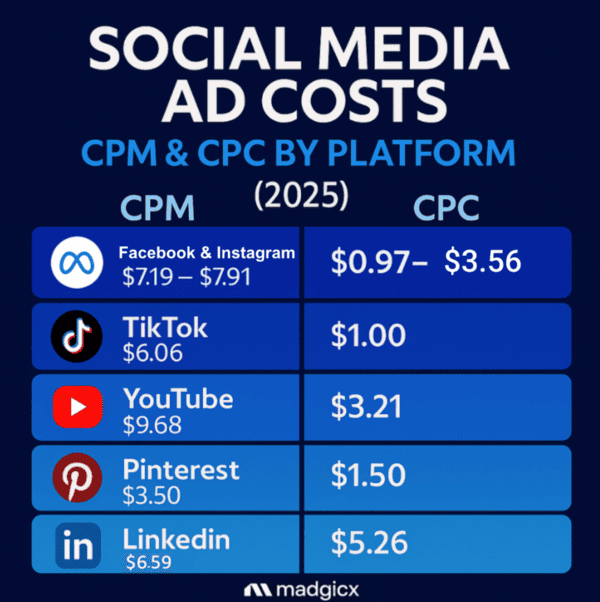
Facebook & Instagram
- CPM: $7.19 – $7.91
- CPC: $0.97 - $3.56
- Average CTR: 1.1%-1.3%
- Best for: E-commerce, lead generation, brand awareness
TikTok
- CPM: $6.06
- CPC: $1.00
- Average CTR: 0.84%
- Best for: Product discovery, younger demographics, viral content
YouTube
- CPM: $9.68
- CPC: $3.21
- Average CTR: 0.65%
- Best for: Education, demonstrations, high-value products
- CPM: $6.59
- CPC: $5.26
- Average CTR: 0.44%-0.65%
- Best for: B2B services, professional products, high-ticket items
- CPM: $3.50
- CPC: $1.50
- Average CTR: 0.2% to 1.5%
- Best for: Home decor, fashion, food, lifestyle products
What These Numbers Actually Mean for Your Budget
If you're spending $1,000/month on social media advertising, here's roughly how many people you'll reach on each platform:
- Facebook/Instagram: 126,000 – 139,000 impressions
- TikTok: ~165,000 impressions
- YouTube: ~103,000 impressions
- LinkedIn: ~151,000 impressions
- Pinterest: ~286,000 impressions
Remember, impressions don't equal results. A smaller, highly targeted audience often outperforms a massive reach with poor targeting. Focus on platforms where your ideal customers actually spend time and engage with content.
Platform-by-Platform Breakdown: Where to Spend Your Ad Dollars
Facebook & Instagram: The E-commerce Powerhouse
Who's Here: over 5 billion monthly active users across both platforms, with the strongest e-commerce integration of any social network.
Best For: Product sales, retargeting campaigns, lookalike audience expansion, and detailed demographic targeting.
Key Ad Formats:
- Instagram Shop Ads: Direct product catalog integration with seamless checkout
- Advantage+ Catalog Ads: Automatically show relevant products to people who've visited your website
- Story Ads: Full-screen, immersive content that feels native to the platform
- Reels Ads: Short-form video content that leverages Instagram's algorithm
The Instagram Shop Advantage: Meta's 2024 performance study found that businesses using Instagram Shop ads saw a 24% reduction in cost per purchase compared to standard conversion campaigns. This isn't just about lower costs—it's about creating a frictionless shopping experience that converts browsers into buyers.

Pro Tip: Use Facebook's Advantage+ Sales campaigns for automated optimization across both platforms. The AI automatically allocates budget between Facebook and Instagram based on where your audience is most likely to convert.
TikTok: The Discovery Engine
Who's Here: Just over 1.5 billion users, with 71% under age 34, but rapidly expanding into older demographics.
Best For: Product discovery, brand awareness, viral content, and reaching younger audiences with authentic, entertaining content.
Key Ad Formats:
- Spark Ads: Boost organic content that's already performing well
- Collection Ads: Showcase multiple products in a browsable format
- TopView Ads: Premium placement that guarantees maximum visibility
- Branded Hashtag Challenges: User-generated content campaigns that can go viral
The Spark Ads Secret: Unlike other platforms where you create separate ad content, TikTok's Spark Ads let you promote your existing organic posts that are already gaining traction. This maintains authenticity while amplifying reach—a combination that's proven to drive higher engagement rates.
Speaking of high engagement rates...We’ve got a quick-read guide on how to increase social media engagement. It breaks down exactly how to increase social media engagement—plus the key metrics you should be tracking to see what’s actually working.
Budget Reality Check: TikTok requires a minimum daily budget of $20 per ad group, making it less accessible for very small budgets. However, the platform's algorithm is incredibly efficient at finding your ideal audience quickly.
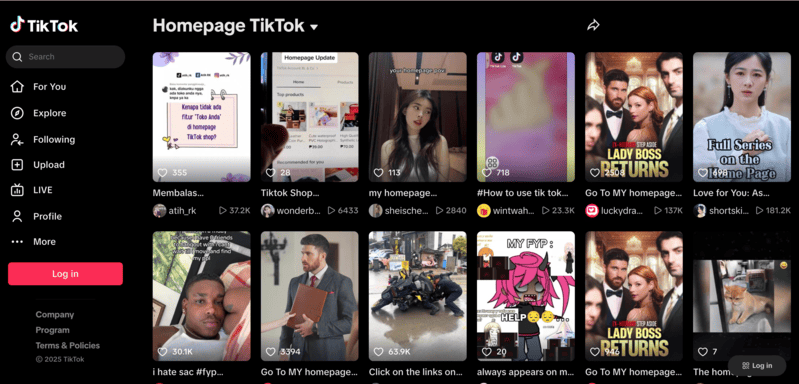
YouTube: The Education Platform
Who's Here: Just over 2.5 billion logged-in monthly users who actively search for solutions to their problems.
Best For: Product demonstrations, educational content, high-consideration purchases, and building trust through longer-form content.
Key Ad Formats:
- YouTube Shorts Ads: Compete directly with TikTok's short-form content
- In-Stream Ads: Traditional video ads that play before, during, or after videos
- Discovery Ads: Appear in search results and suggested video feeds
- Demand Gen Campaigns: Combines video + image ads across YouTube, Gmail, and Discover
The Multi-Platform Multiplier: Strike Social's 2025 study revealed that combining YouTube ads with Google Search campaigns resulted in a 23% reduction in cost per acquisition and 15x higher ROAS compared to using either platform alone. The reason? YouTube builds awareness and consideration, while Search captures intent.
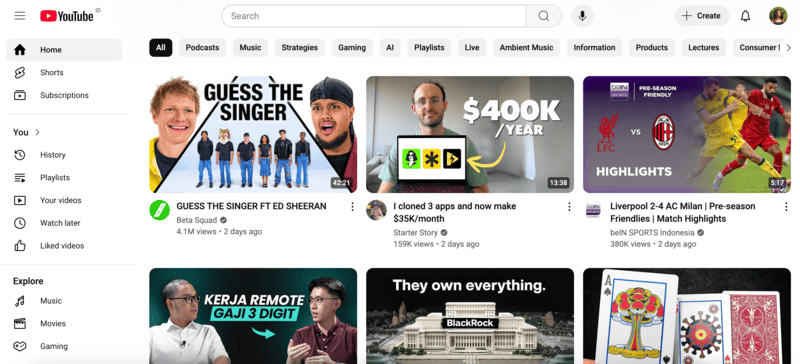
LinkedIn: The B2B Goldmine
Who's Here: 1.1 billion professionals and more than 69 million companies.
Best For: B2B lead generation, professional services, high-ticket B2C products, and reaching people in their professional mindset.
Key Ad Formats:
- Sponsored Content: Native posts that appear in the LinkedIn feed
- Message Ads: Direct messages sent to targeted LinkedIn members
- Dynamic Ads: Personalized ads using LinkedIn profile data
- Event Ads: Promote webinars, conferences, and virtual events
Why LinkedIn Costs More (And Why It's Worth It): Yes, LinkedIn's CPCs are 3-5x higher than other platforms, but the quality of leads often justifies the cost. If your average customer value exceeds $ 500, LinkedIn's precision targeting of job titles, company sizes, and industries can deliver an exceptional ROI.
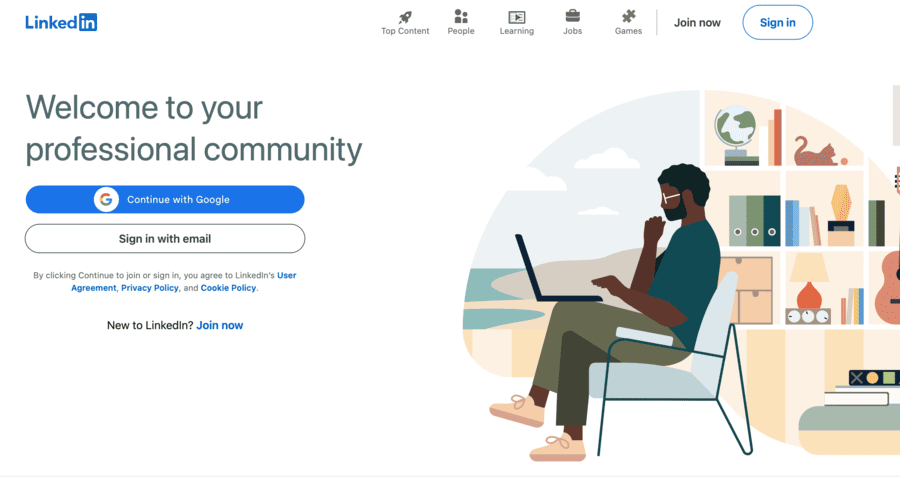
Pinterest: The Intent-Driven Discovery Platform
Who's Here: 570 million monthly active users, 70.3% female, with high purchase intent and longer consideration periods.
Best For: Home decor, fashion, food, beauty, wedding planning, and any visually-driven products with strong seasonal trends.
Key Ad Formats:
- Shopping Ads: Product catalog integration with real-time pricing
- Video Ads: Short videos that autoplay in the feed
- Carousel Ads: Multiple images showcasing different products or angles
- Idea Ads: Native content that provides inspiration and solutions
The Pinterest Advantage: Users come to Pinterest to plan purchases, not just browse. This intent-driven behavior yields higher conversion rates and longer customer lifetime values, particularly for lifestyle and home-related products.
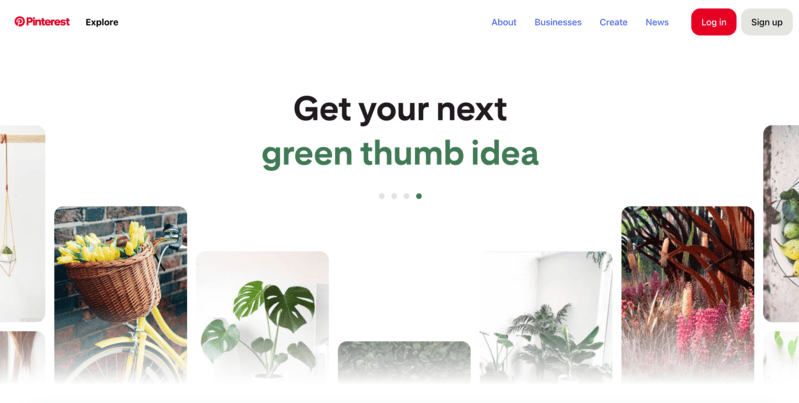
Want to see what all this looks like in action? Check out these bold ad examples to get real-world inspiration from brands that are doing social ads right.
How to Choose the Right Platform for Your Business
Stop trying to be everywhere at once. The most successful e-commerce businesses in 2025 master 1-2 platforms before expanding to others. Here's how to choose your starting point:
Start With Your Customer Demographics
If your ideal customer is:
- 18-34 years old: Start with TikTok or Instagram
- 25-45 years old: Facebook and Instagram combination
- 35-55 years old: Facebook and YouTube
- Professional/B2B: LinkedIn first, then YouTube for education
- Planning purchases: Pinterest, then retarget on Facebook
Consider Your Product Type
- Visual Products (fashion, home decor, food): Instagram, Pinterest, TikTok
- Complex Products (software, services): YouTube, LinkedIn, Facebook
- Impulse Purchases (under $50): TikTok, Instagram, Facebook
- High-Consideration (over $200): YouTube, Facebook, LinkedIn
Match Your Content Capabilities
- Limited video production: Start with Facebook/Instagram static ads
- Strong video content: TikTok, YouTube, Instagram Reels
- Educational content: YouTube, LinkedIn, Facebook
- User-generated content: TikTok, Instagram, Pinterest
If your brand is big on the ‘gram, don’t just wing the ads. Learn how to actually promote on Instagram—our article contains fundamental strategies that drive clicks, conversions, and community.
Budget Considerations
- $500-$1,000/month: Focus on one platform (Facebook/Instagram recommended)
- $1,000-$3,000/month: Master one platform, test a second
- $3,000+/month: Expand to 2-3 platforms with proper attribution tracking
The 80/20 Rule for Platform Selection: We recommend allocating 80% of your budget to your primary platform until you achieve consistent profitability, then use 20% to test secondary platforms. This prevents the common mistake of spreading the budget too thin across multiple platforms without achieving meaningful results on any of them.
9-Step Social Media Advertising Launch Process
Here's the exact process we recommend for launching your first profitable social media advertising campaign in 2025. This framework works regardless of which platform you choose, but we'll use Facebook/Instagram examples since they're the most common starting point for e-commerce businesses.
Step 1: Define Your Campaign Objectives
Start with business goals, not platform metrics. Instead of "increase reach" or "get more clicks," define what success actually looks like:
- Acquire 100 new customers at $25 cost per acquisition
- Generate $10,000 in revenue with a 4 ROAS minimum
- Build an email list of 500 qualified leads for the upcoming product launch
- Increase repeat purchase rate from existing customers by 15%
Match objectives to campaign types:
- Sales: Conversion campaigns optimized for purchases
- Lead Generation: Lead ads or traffic campaigns to landing pages
- Brand Awareness: Reach campaigns with frequency caps
- Retargeting: Advantage+ Catalog ads or custom audience campaigns
Step 2: Platform Selection and Account Setup
Based on your analysis from the previous section, choose your primary platform and ensure proper setup:
Facebook/Instagram Setup:
- Install Facebook Pixel on your website
- Connect your product catalog for Advantage+ Catalog Ads
- Set up Conversions API for iOS tracking improvements
- Create a Facebook Business Manager with proper permissions
Account Structure Best Practices:
- One campaign per objective
- 3-5 ad sets per campaign (different audiences)
- 2-3 ads per ad set (creative variations)
Step 3: Audience Building and Research
Start with three core audience types:
Lookalike Audiences (if you have existing customers):
- 1% lookalike of your best customers (highest LTV)
- 1% lookalike of recent purchasers (last 90 days)
- 2%-3% lookalike for broader reach testing
Interest-Based Audiences:
- Direct competitors' audiences
- Complementary brands and influencers
- Industry publications and websites
- Related product categories
Custom Audiences for Retargeting:
- Website visitors (last 30, 60, 180 days)
- Email subscribers who haven't purchased
- Past customers for repeat purchase campaigns
- Cart abandoners and checkout initiators
.png)
Step 4: Creative Development and Testing
The 3x3x3 Creative Framework:
- 3 ad formats: Single image, carousel, video
- 3 messaging angles: Problem-focused, benefit-focused, social proof
- 3 visual styles: Product-focused, lifestyle, user-generated content
Creative Best Practices for 2025:
- Mobile-first design: 98% of social media usage time is on mobile
- Native feel: Ads should feel like organic content, not obvious advertisements
- Clear value proposition: What's in it for the customer within the first 3 seconds
- Strong call to action: Specific action you want them to take
Pro Tip: Use tools like Madgicx's AI Ad Generator to create multiple creative variations quickly. The AI analyzes your product images and generates thumb-stopping ad creatives that follow current best practices.
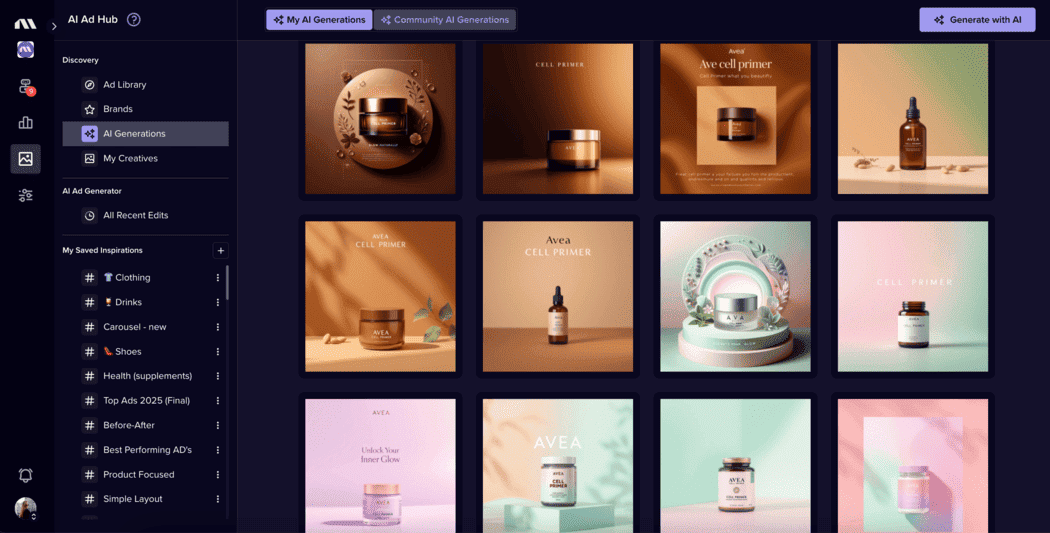
Step 5: AI Optimization Setup
This is where most businesses miss out on significant performance improvements. Instead of manually managing bids, budgets, and placements, set up automated optimization from day one.
Platform-Native AI Features:
- Advantage+ Sales Campaigns: Let Facebook's AI handle audience expansion and budget allocation
- Advantage+ Placements: Allow ads to show where they'll perform best
- Advantage+ Creative: Automatically optimize ad presentation using AI-enhanced combinations of headlines, images, and descriptions.
Third-Party AI Optimization:
Tools like Madgicx take optimization beyond what platforms offer natively:
- 24/7 monitoring: Catch performance drops before they waste budget
- Cross-platform reporting: Monitor Facebook, Google, and TikTok from one dashboard
- Predictive scaling: Identify winning campaigns before they plateau

Step 6: Tracking Implementation
Essential Tracking Setup:
- Facebook Pixel: Basic conversion tracking
- Conversions API: Server-side tracking for iOS improvements
- Google Analytics 4: Website behavior and attribution
- UTM parameters: Track traffic sources and campaign performance
Advanced Attribution:
Consider implementing Madgicx's Cloud Tracking for improved data accuracy. Server-side tracking helps recover conversion data lost due to iOS privacy updates, providing clearer ROI visibility.
Step 7: Campaign Launch and Initial Monitoring
Launch Strategy:
- Start with $20-$50/day per ad set (depending on your average cost per purchase)
- Run for 3-7 days before making major changes
- Monitor for delivery issues, not just performance metrics
- Ensure ads are spending budget and reaching intended audiences
First 48 Hours Checklist:
✅ Ads are delivering and spending budget
✅ Tracking is recording conversions correctly
✅ No policy violations or disapprovals
✅ Cost per click is within the expected range
Step 8: Performance Analysis and Optimization
Key Metrics to Monitor:
- ROAS (Return on Ad Spend): Revenue ÷ Ad Spend
- Cost Per Acquisition: Ad Spend ÷ Conversions
- Click-Through Rate: Clicks ÷ Impressions
- Conversion Rate: Conversions ÷ Clicks
- Frequency: How often people see your ads
Weekly Optimization Tasks:
- Pause underperforming ads (CPA 50%+ above target)
- Increase budget on winning ad sets by 20%-30%
- Test new creative variations
- Expand successful audiences with broader targeting
- Analyze which social media campaigns drive the highest lifetime value
Step 9: Scaling Strategy
Horizontal Scaling (reaching more people):
- Expand lookalike audiences (3%, 5%, 10%)
- Test new interest-based audiences
- Add new geographic locations
- Launch on additional platforms
Vertical and Horizontal Scaling (spending more on what works):
- Increase daily budgets by 20%-30% every 3-5 days
- Duplicate winning campaigns with higher budgets
- Expand successful ad sets to broader audiences
- Increase bids for premium placements
The Scaling Trap to Avoid: Don't increase budgets too quickly. Facebook's algorithm needs time to adjust to budget changes. Doubling budgets overnight often leads to performance drops and wasted spend.
AI-Powered Optimization Strategies That Actually Work
Here's the reality: manually managing social media campaigns in 2025 is like trying to compete in Formula 1 with a horse and buggy. The platforms process billions of data points every second to optimize ad delivery, and human brains simply can't keep up.
But here's what most businesses get wrong—they think AI optimization means "set it and forget it." That's not how it works. AI amplifies good strategy and accelerates bad strategy equally. You need to understand how to work with AI, not just turn it on and hope for the best.
Platform-Native AI Features You Should Be Using
Facebook's Advantage+ Sales Campaigns
This is Facebook's most advanced AI-powered campaign type, designed specifically for e-commerce businesses. Instead of manually creating audiences, the AI finds your ideal customers across Facebook and Instagram automatically.
How it works:
- Upload your product catalog
- Set your target ROAS or cost per acquisition
- Let the AI test audiences, placements, and creative combinations
- Budget automatically shifts to the highest-performing combinations
Google's Performance Max Campaigns
A similar concept to Facebook's Advantage+, but it works across all Google properties, including Search, YouTube, Gmail, Discover, and the Display Network.
TikTok's Smart Performance Campaigns
Automatically optimizes for your conversion goals while expanding reach to similar audiences based on engagement patterns.
Advanced AI Optimization with Third-Party Tools
While platform-native AI is powerful, it's limited to the data available on each platform. Third-party AI tools, such as Madgicx, can help you optimize across platforms by providing insights that individual platforms can't see.
Cross-Platform Budget Allocation
Instead of manually deciding how much to spend on Facebook vs. Google vs. TikTok, AI can help you shift budgets to the platforms and campaigns delivering the best results in real-time.
Predictive Performance Analysis
AI can identify campaigns that are about to plateau or decline before it happens, allowing you to pause them before they waste budget or scale them before they become saturated.
Creative Performance Prediction
Advanced AI can analyze your creative assets and predict performance before you even launch them, helping you prioritize which ads to test first.
Setting Up AI Optimization Rules
Budget Management Rule Examples:
- Increase budget by 20% when ROAS exceeds target by 25%
- Pause campaigns when CPA exceeds the target by 50%
- Reallocate budget from underperforming to winning campaigns daily
Creative Testing Rule Examples:
- Launch new creative variations when frequency exceeds 3.0
- Pause ads with CTR below 1.0% after 1,000 impressions
- Duplicate winning ads to new audiences automatically
Audience Expansion Rule Examples:
- Create lookalike audiences from converters every 100 conversions
- Expand interest targeting when the audience overlap drops below 10%
- Test broader demographics when narrow targeting reaches saturation
The Human + AI Optimization Framework
What AI Does Best:
- Process massive amounts of data instantly
- Identify patterns humans can't see
- Make bid adjustments in real-time
- Test thousands of combinations simultaneously
- Optimize for key performance indicators (KPIs), such as ROAS, CPA, etc.
What Humans Do Best:
- Understand brand voice and messaging
- Create emotional connections with customers
- Interpret business context and market changes
- Make strategic decisions about new products or markets
- Understand customer lifetime value beyond immediate conversions
The Winning Combination: Use AI for tactical optimization (bids, budgets, audience expansion) while humans focus on strategy (messaging, positioning, creative direction, long-term planning).
Measuring Success: KPIs and ROAS Calculation
Let's talk about the metrics that actually matter for your business. Too many e-commerce owners get caught up in vanity metrics like reach and impressions while ignoring the numbers that directly impact their bottom line.
The Only 5 Metrics You Need to Track
1. Return on Ad Spend (ROAS)
- Formula: Revenue from ads ÷ Amount spent on ads
- Target: Minimum 3 for most e-commerce businesses (varies by industry and profit margins)
- Example: $3,000 revenue ÷ $1,000 ad spend = 3 ROAS
2. Customer Acquisition Cost (CAC)
- Formula: Total ad spend ÷ Number of new customers acquired
- Target: Should be 20%-30% of your average customer lifetime value
- Example: $1,000 ad spend ÷ 25 new customers = $40 CPA
3. Customer Lifetime Value (LTV)
- Formula: Average order value × Purchase frequency × Customer lifespan
- Target: LTV should be 3-5x your CPA for sustainable growth
- Example: $80 AOV × 3 purchases/year × 2 years = $480 LTV
4. Click-Through Rate (CTR)
- Formula: Clicks ÷ Impressions × 100
- Target: 1.5%+ for Facebook/Instagram, 2.0%+ for TikTok
- Why it matters: Higher CTR = lower costs and better ad relevance
5. Conversion Rate
- Formula: Conversions ÷ Clicks × 100
- Target: 2%-4% for cold traffic, 5%-15% for retargeting
- Why it matters: Indicates how well your landing page and offer convert visitors
Industry-Specific ROAS Benchmarks
Fashion & Apparel: 4-6 ROAS
Beauty & Cosmetics: 4 to 7 ROAS
Home & Garden: 3-4 ROAS
Electronics: 3 to 5 ROAS
Jewelry: 2.5 ROAS
Health & Wellness: 3-5 ROAS
Why the variation? Industries with higher profit margins (jewelry, beauty) can sustain higher advertising costs, while lower-margin businesses (electronics) need to be more efficient with ad spend.
Advanced Attribution and Multi-Touch Analysis
The Attribution Challenge
Facebook might show a 4 ROAS while Google Analytics shows a 2 ROAS for the same campaigns. Which one is right? Usually, the truth is somewhere in between.
Why Attribution is Broken:
- iOS privacy updates limit pixel tracking
- Customers use multiple devices before purchasing
- Cross-platform customer journeys aren't tracked properly
- Platform attribution models favor their own contribution
Solutions for Better Attribution:
- Use multiple data sources: Compare platform data with Google Analytics and your e-commerce platform
- Implement server-side tracking: Tools like Madgicx's Cloud Tracking recover lost conversion data
- Track customer surveys: Ask new customers how they found you
- Use UTM parameters: Track specific campaigns and traffic sources
- Focus on blended metrics: Look at overall business performance, not just platform-reported ROAS
Setting Up Your ROAS Calculation System
Basic ROAS Calculation:
Daily ROAS = Revenue from ads today ÷ Ad spend today
Weekly ROAS = Revenue from ads this week ÷ Ad spend this week
Monthly ROAS = Revenue from ads this month ÷ Ad spend this month
Advanced ROAS with Customer Lifetime Value:
True ROAS = (Immediate revenue + Projected LTV) ÷ Ad spend
Example:
- Immediate revenue: $100
- Projected 12-month LTV: $200
- Ad spend: $50
- True ROAS: ($100 + $200) ÷ $50 = 6
This approach takes into account repeat purchases and long-term customer value, providing a more accurate picture of campaign profitability.
Pro Tip: Set up automated ROAS reporting using tools that connect your ad platforms with your e-commerce data. Manual calculations are prone to errors and don't provide real-time insights necessary for making quick optimization decisions.
For more detailed guidance on tracking and measuring your advertising performance, check out our comprehensive guide on social media analytics.
Frequently Asked Questions
What's the average cost of social media advertising in 2025?
Based on current data, the average CPM across all platforms is $6.06, but costs vary significantly by platform and targeting. Facebook and Instagram typically cost $7.19 to $7.91 per 1,000 impressions, while LinkedIn costs around $6.59 per 1,000 impressions. Your actual costs depend on your audience, competition, and campaign optimization.
Which platform has the lowest CPM?
Pinterest currently offers the lowest CPMs at $3.50 per 1,000 impressions, followed by TikTok at $6.06. However, lower CPM doesn't always mean better ROI—focus on platforms where your target audience is most active and engaged.
How do I calculate ROAS for social media ads?
ROAS (Return on Ad Spend) = Revenue from ads ÷ Amount spent on ads. For example, if you spend $1,000 on ads and generate $4,000 in revenue, your ROAS is 4. Most e-commerce businesses need a minimum 3 ROAS to be profitable, but this varies based on profit margins and customer lifetime value.
Is social media advertising worth it for small businesses?
Yes, but with the right strategy. Small businesses should start with $500-$1,000/month budgets focused on one platform (usually Facebook/Instagram) rather than spreading the budget across multiple platforms. The key is to start small, test what works, and then scale successful campaigns gradually.
How often should I update my ad creatives?
Monitor your ad frequency (how often people see your ads). When frequency reaches 3.0 or higher, it's time to refresh your creatives. For most campaigns, this means updating creatives every 2-4 weeks. High-performing ads can run longer, while underperforming ads should be paused within the first week.
What's the difference between CPM and CPC?
CPM (Cost Per Mille) is what you pay for 1,000 impressions—how much it costs to show your ad to 1,000 people. CPC (Cost Per Click) is what you pay each time someone clicks your ad. CPM is better for brand awareness campaigns, while CPC is more relevant for driving traffic and conversions.
How long should I run ads before making changes?
Give new campaigns at least 3-7 days and 50+ conversions before making major changes. Facebook's algorithm needs time to learn and optimize. Making changes too quickly can reset the learning phase and hurt performance. Monitor for delivery issues immediately, but wait for statistical significance before making any optimizations.
Can I run social media ads without a big budget?
Absolutely. You can start with as little as $10-$20/day on most platforms. The key is to focus your budget on one platform and one campaign objective, rather than spreading it too thin. Start small, find what works, then gradually increase your budget as you see positive results.
Start Your First Profitable Social Media Campaign
Social media advertising in 2025 isn't about choosing the perfect platform or writing the perfect ad copy—it's about understanding your customers, testing systematically, and leveraging AI to optimize faster than your competitors.
The brands winning right now are the ones that stopped trying to do everything manually and started working with AI to amplify their results. They're not just throwing money at ads and hoping for the best. They're utilizing data-driven strategies, automated optimization, and clear measurement frameworks to develop sustainable and profitable advertising systems.
Your next steps are simple:
- Choose your primary platform based on where your customers spend time
- Set up proper tracking so you can measure real ROI, not vanity metrics
- Start with AI optimization from day one—don't wait until you're already behind
- Focus on one campaign objective until you achieve consistent profitability
- Scale gradually based on data, not emotions or gut feelings
The most successful e-commerce businesses we work with treat social media advertising like a science, not an art. They test hypotheses, measure results, and refine their approach by doubling down on what works while quickly eliminating what doesn't.
Tools like Madgicx can streamline the entire Meta ad optimization process, letting you focus on growing your business instead of managing ads. The AI handles bid adjustments, budget reallocation, and performance monitoring 24/7, while you focus on product development, customer service, and strategic growth.
Ready to launch your first AI-optimized campaign? The question isn't whether you should use AI—it's whether you can afford not to. Give Madgicx’s AI-powered campaigns a spin—start your free trial today.
Stop wasting time on manual budget tweaks and endless testing. Madgicx's AI Marketer provides real-time optimization recommendations for your Meta ads that you can act on instantly, with a single click. Shift budgets to winners, pause underperformers, and scale faster without guesswork.
Digital copywriter with a passion for sculpting words that resonate in a digital age.




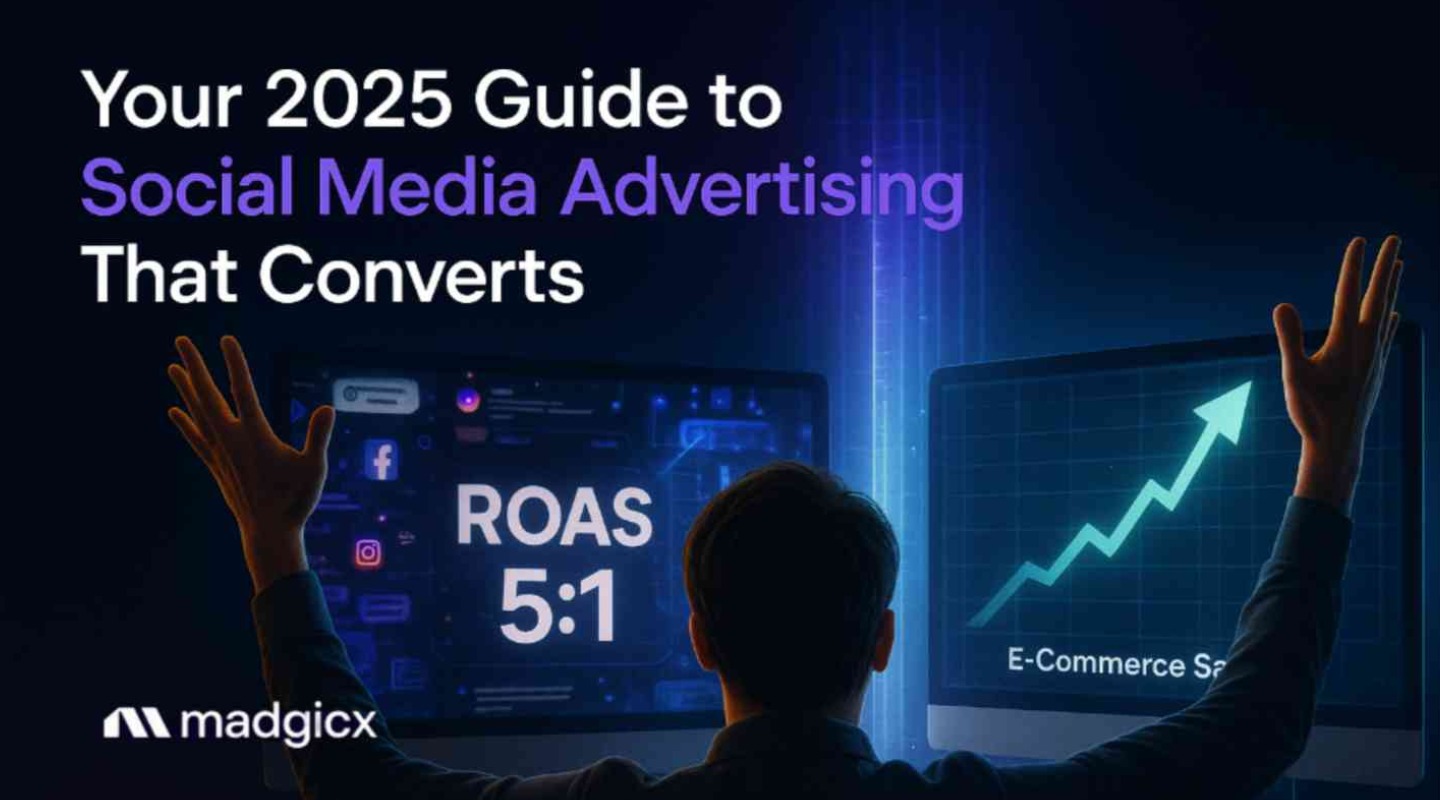


.avif)







